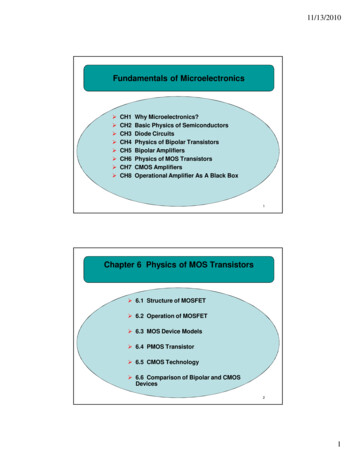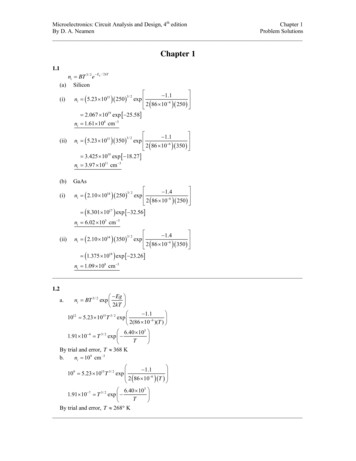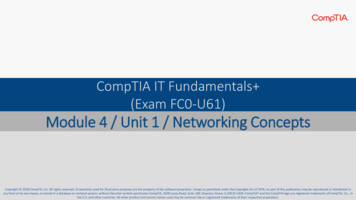
Transcription
11/13/2010Fundamentals of Microelectronics CH1CH2CH3CH4CH5CH6CH7CH8Why Microelectronics?Basic Physics of SemiconductorsDiode CircuitsPhysics of Bipolar TransistorsBipolar AmplifiersPhysics of MOS TransistorsCMOS AmplifiersOperational Amplifier As A Black Box1Chapter 6 Physics of MOS Transistors 6.1 Structure of MOSFET 6.2 Operation of MOSFET 6.3 MOS Device Models 6.4 PMOS Transistor 6.5 CMOS Technology 6.6 Comparison of Bipolar and CMOSDevices21
11/13/2010Chapter OutlineCH 6 Physics of MOS Transistors3Metal-Oxide-Semiconductor (MOS) Capacitor The MOS structure can be thought of as a parallel-platecapacitor, with the top plate being the positive plate, oxidebeing the dielectric, and Si substrate being the negativeplate. (We are assuming P-substrate.)CH 6 Physics of MOS Transistors42
11/13/2010Structure and Symbol of MOSFET This device is symmetric, so either of the n regions can besource or drain.CH 6 Physics of MOS Transistors5State of the Art MOSFET Structure The gate is formed by polysilicon, and the insulator bySilicon dioxide.CH 6 Physics of MOS Transistors63
11/13/2010Formation of Channel First, the holes are repelled by the positive gate voltage,leaving behind negative ions and forming a depletionregion. Next, electrons are attracted to the interface,creating a channel (“inversion layer”).CH 6 Physics of MOS Transistors7Voltage-Dependent Resistor The inversion channel of a MOSFET can be seen as aresistor. Since the charge density inside the channel depends on thegate voltage, this resistance is also voltage-dependent.CH 6 Physics of MOS Transistors84
11/13/2010Voltage-Controlled Attenuator As the gate voltage decreases, the output drops becausethe channel resistance increases. This type of gain control finds application in cell phones toavoid saturation near base stations.CH 6 Physics of MOS Transistors9MOSFET Characteristics The MOS characteristics are measured by varying VG whilekeeping VD constant, and varying VD while keeping VGconstant. (d) shows the voltage dependence of channel resistance.CH 6 Physics of MOS Transistors105
11/13/2010L and tox Dependence Small gate length and oxide thickness yield low channelresistance, which will increase the drain current.CH 6 Physics of MOS Transistors11Effect of W As the gate width increases, the current increases due to adecrease in resistance. However, gate capacitance alsoincreases thus, limiting the speed of the circuit. An increase in W can be seen as two devices in parallel.CH 6 Physics of MOS Transistors126
11/13/2010Channel Potential Variation Since there’s a channel resistance between drain andsource, and if drain is biased higher than the source,channel potential increases from source to drain, and thepotential between gate and channel will decrease fromsource to drain.CH 6 Physics of MOS Transistors13Channel Pinch-Off As the potential difference between drain and gate becomes morepositive, the inversion layer beneath the interface starts to pinchoff around drain. When VD – VG Vth, the channel at drain totally pinches off, andwhen VD – VG Vth, the channel length starts to decrease.CH 6 Physics of MOS Transistors147
11/13/2010Channel Charge DensityQ WCox (VGS VTH ) The channel charge density is equal to the gate capacitancetimes the gate voltage in excess of the threshold voltage.CH 6 Physics of MOS Transistors15Charge Density at a PointQ( x) WCox[VGS V ( x) VTH ] Let x be a point along the channel from source to drain, andV(x) its potential; the expression above gives the chargedensity (per unit length).CH 6 Physics of MOS Transistors168
11/13/2010Charge Density and CurrentI Q v The current that flows from source to drain (electrons) isrelated to the charge density in the channel by the chargevelocity.CH 6 Physics of MOS Transistors17Drain Currentv µndVdxID WCox[VGS V (x) VTH ]µndV(x)dx1WID µnCox [2(VGS VTH )VDS VDS2 ]2LCH 6 Physics of MOS Transistors189
11/13/2010Parabolic ID-VDS Relationship By keeping VG constant and varying VDS, we obtain aparabolic relationship. The maximum current occurs when VDS equals to VGS- VTH.CH 6 Physics of MOS Transistors19ID-VDS for Different Values of VGSI D ,max (VGS VTH )2CH 6 Physics of MOS Transistors2010
11/13/2010Linear Resistance1Ron µ nCoxW(VGS VTH )L At small VDS, the transistor can be viewed as a resistor,with the resistance depending on the gate voltage. It finds application as an electronic switch.CH 6 Physics of MOS Transistors21Application of Electronic Switches In a cordless telephone system in which a single antenna isused for both transmission and reception, a switch is usedto connect either the receiver or transmitter to the antenna.CH 6 Physics of MOS Transistors2211
11/13/2010Effects of On-Resistance To minimize signal attenuation, Ron of the switch has to beas small as possible. This means larger W/L aspect ratioand greater VGS.CH 6 Physics of MOS Transistors23Different Regions of OperationCH 6 Physics of MOS Transistors2412
11/13/2010How to Determine ‘Region of Operation’ When the potential difference between gate and drain isgreater than VTH, the MOSFET is in triode region. When the potential difference between gate and drainbecomes equal to or less than VTH, the MOSFET enterssaturation region.CH 6 Physics of MOS Transistors25Triode or Saturation? When the region of operation is not known, a region isassumed (with an intelligent guess). Then, the final answeris checked against the assumption.CH 6 Physics of MOS Transistors2613
11/13/2010Channel-Length Modulation1W2I D µ nCox (VGS VTH ) (1 λVDS )2L The original observation that the current is constant in thesaturation region is not quite correct. The end point of thechannel actually moves toward the source as VD increases,increasing ID. Therefore, the current in the saturationregion is a weak function of the drain voltage.CH 6 Physics of MOS Transistors27λ and L Unlike the Early voltage in BJT, the channel- lengthmodulation factor can be controlled by the circuit designer. For long L, the channel-length modulation effect is lessthan that of short L.CH 6 Physics of MOS Transistors2814
11/13/2010Transconductanceg m µ nCoxW(VGS VTH )Lg m 2µ n CoxWIDLgm 2I DVGS VTH Transconductance is a measure of how strong the draincurrent changes when the gate voltage changes. It has three different expressions.CH 6 Physics of MOS Transistors29Doubling of gm Due to Doubling W/L If W/L is doubled, effectively two equivalent transistors areadded in parallel, thus doubling the current (if VGS-VTH isconstant) and hence gm.CH 6 Physics of MOS Transistors3015
11/13/2010Velocity SaturationI D vsat Q vsat WCox (VGS VTH )gm I D vsatWCox VGS Since the channel is very short, it does not take a very largedrain voltage to velocity saturate the charge particles. In velocity saturation, the drain current becomes a linearfunction of gate voltage, and gm becomes a function of W.CH 6 Physics of MOS Transistors31Body EffectVTH V TH 0 ρ ( 2φ F V SB 2φ F) As the source potential departs from the bulk potential, thethreshold voltage changes.CH 6 Physics of MOS Transistors3216
11/13/2010Large-Signal Models Based on the value of VDS, MOSFET can be representedwith different large-signal models.CH 6 Physics of MOS Transistors33Example: Behavior of ID with V1 as a Function1W2ID µnCox (VDD V1 VTH )2L Since V1 is connected at the source, as it increases, thecurrent drops.CH 6 Physics of MOS Transistors3417
11/13/2010Small-Signal Modelro 1λI D When the bias point is not perturbed significantly, smallsignal model can be used to facilitate calculations. To represent channel-length modulation, an outputresistance is inserted into the model.CH 6 Physics of MOS Transistors35PMOS Transistor Just like the PNP transistor in bipolar technology, it ispossible to create a MOS device where holes are thedominant carriers. It is called the PMOS transistor. It behaves like an NMOS device with all the polaritiesreversed.CH 6 Physics of MOS Transistors3618
11/13/2010PMOS Equations1W2I D , sat µ p Cox (VGS VTH ) (1 λVDS )2L1WI D ,tri µ p Cox [2(VGS VTH )VDS VDS2 ]2L1W2I D , sat µ p Cox (VGS VTH ) (1 λ VDS )2L1WI D ,tri µ p Cox [2(VGS VTH )VDS VDS2 ]2LCH 6 Physics of MOS Transistors37Small-Signal Model of PMOS Device The small-signal model of PMOS device is identical to thatof NMOS transistor; therefore, RX equals RY and hence(1/gm) ro.CH 6 Physics of MOS Transistors3819
11/13/2010CMOS Technology It possible to grow an n-well inside a p-substrate to create atechnology where both NMOS and PMOS can coexist. It is known as CMOS, or “Complementary MOS”.CH 6 Physics of MOS Transistors39Comparison of Bipolar and MOS Transistors Bipolar devices have a higher gm than MOSFETs for a givenbias current due to its exponential IV characteristics.CH 6 Physics of MOS Transistors4020
CH 6 Physics of MOS Transistors 31 Velocity Saturation Since the channel is very short, it does not take a very large drain voltage to velocity saturate the charge particles. In velocity saturation, the drain current becomes a linear function of gate voltage, and gm becomes a function of W. ( ) sat ox GS D m D sat sat ox GS TH v WC V I g I v Q .










